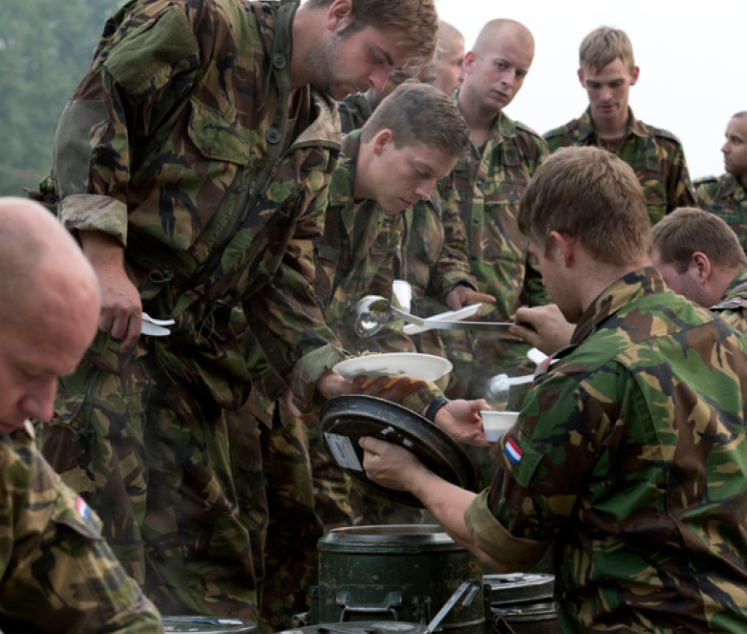In the Food 4 Health and Safety Challenge, third-year bachelor and master students from different disciplines were challenged to reflect on the food supply for the Dutch armed forces. In this course of 7,5 ECTS, learners worked in interdisciplinary teams on the following topic:
“Develop a new food concept for military on exercises and missions. This should be sustainable, satisfactory to the military, and suiting to the food-requirements set by the Ministry of Defence.”

The Dutch Military contributes to freedom, safety, and welfare in the Netherlands and abroad. It is essential they have adequate high-nutritional value food. Currently, three types of food are provided. The first and most basic level is rationed, provided Meal Ready-to-Eat (MRE) bags. These provide food to the soldier for three days while on the battlefield. The second level consists of frozen, fresh meals which require heating via the Mobile Satellite Kitchen (MSK). These come in single and multiple portions. The third level is more extensive, being prepared in a barracks kitchen by cooks. The learner teams had to propose solutions for a new food concept for the military.
Learning outcomes
After successful completion of this course learners were expected to be able to:
- Analyse the context of a real-life problem and distinguish the most relevant elements for designing a solution.
- Assess opportunities offered by the existing state-of-the-art technologies and solutions and identify areas for innovation relevant to solving a real-life challenge.
- Gathering, select and analysing information, tools and techniques and integrating this into final project deliverables in terms of process and content at an academic level.
- Discuss and defend their viewpoints and conclusions in a professional and academically correct way.
- Set and reflect on personal learning goals based on their expertise and that of other members and stakeholder, in a cyclic manner leading to future reflections and actions.
Learning journey
The image below shows planning and schedule that was used for this course.

Assessment
The final assessment was divided into a number of group and individual deliverables.
- The group deliverables (proof of concept and advisory report) were reviewed per team, accounting for 70% of the final grade.
- Proof of concept
The aim of a proof of concept is to demonstrate the feasibility of the proposed solution. A proof of concept should be a visual demonstration of the idea. Appropriate means should be used that prove to the challenge agent the feasibility, scalability and practical potential of the concept. It could be a physical prototype, simulation, video, PowerPoints, movie, model, etc. - Advisory report
The advisory report should document the research process and results, and contain a detailed description of the solution, its properties and implementation plan. This report is a product that the assessors can use to determine whether the suggested solution is innovative, feasible, viable, and desirable to the user. The report should be c. 10 A4 pages and required to address essential points and contain specific elements. Learners should bear in mind that there is specific information that the challenge agent expects to see in the report. This includes a problem definition, target group, existing solutions or technologies that would be an opportunity, argumentation for the chosen solution, the potential or further development of the current solution, financial analysis, SWOT analysis, an implementation plan, involved parties, proof of concept description and validation process.
- Proof of concept
- For the individual assessment (30% of the final assessment) the learners set their own learning goals, with support from a coach. They chose what evidence they assemble to support their progress, and when to have feedback moments. During the course, time was allocated for 4 times 30 minutes individual feedback sessions with the coach. These sessions focused on supporting and guiding the learners throughout their learning process. The first session was about defining the learning goals. The following two were for feedback and update; the last session was a checkout point. Every learner created an online portfolio, where they collected written (peer)feedback and add personal reflections. These reflections also served as input for coaching meetings. The coach moderated the reflection cycle to ensure students experienced growth based on new insights from their reflections. During these meetings, the learner took the lead in discussing the topic. The coach provided feedback, entering into a discussion and exploration of the follow-up actions needed for the learner to meet their final learning goal(s).
Course evaluation
Learners received a questionnaire twice during the course, in which they were asked to answer questions about learning activities, organisation of the course, and their learning journey. Feedback from coaches was collected informally during weekly check-ins, as well as in a larger alignment meeting. The overall course got evaluated in an interview with the course coordinator.
General information and contact details of this CBL course can be found here.
